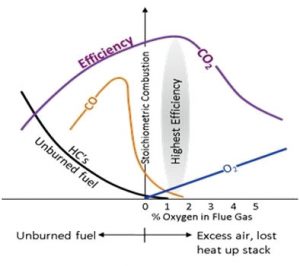By regular measurement of flue gas parameters, you can minimize fuel consumption and unwanted excess pollutants in the environment?
Since many decades industries are dependent on fossil fuels (such as Coal, oil, etc.) for the purpose of production of heat/steam or power generation for the integral part of industries process.
Many medium scales & large-scale industries have their own heat or power generation unit for the purpose of fulfilling of process needs of the industry and lower the dependency on other resources.
During and after the covid situation, many industries are facing financial crises and facing difficulties in sustaining their businesses. Unfortunately, day by day Fossil fuels are degrading and due to lack of availability, the cost of fossil fuels is increasing. The increasing cost of fossil fuels is disturbing the budgets of many industries.
Combustion
Combustion has been the cornerstone of industrial development for nearly two centuries. The burning of fuel to produce heat or other forms of power is an integral part of industrial processes. Combustion is a type of chemical process in which a significant material reacts rapidly with oxygen and gives off heat. The original material is called the fuel, and the source of oxygen is called the oxidizer. During the combustion process, flue gases such as Carbon Monoxide (CO), Carbon Dioxide (CO2), Sulfur (SO2), Nitrogen Dioxide (NOx), Nitric Oxide (NO), Volatile organic compounds (VOCs), and Hydrocarbons (HCs)are generated as a chemical process.
Although progress has been made in understanding the fundamental science of combustion over the years, regulatory and competitive forces are driving the need for combustion equipment with better performance, lower environmental impact, and greater flexibility, all at a reasonable cost.
Boiler’s Combustion Efficiency
 Operating your boiler with an optimum amount of excess air will minimize heat loss up the stack and improve combustion efficiency. Combustion efficiency is a measure of how effectively the heat content of a fuel is transferred into usable heat. The stack temperature and flue gas oxygen (or carbon dioxide) concentrations are primary indicators of combustion efficiency.
Operating your boiler with an optimum amount of excess air will minimize heat loss up the stack and improve combustion efficiency. Combustion efficiency is a measure of how effectively the heat content of a fuel is transferred into usable heat. The stack temperature and flue gas oxygen (or carbon dioxide) concentrations are primary indicators of combustion efficiency.
Given complete mixing, a precise or stoichiometric amount of air is required to completely react with a given quantity of fuel. In practice, combustion conditions are never ideal, and additional or “excess” air must be supplied to completely burn the fuel.
The correct amount of excess air is determined from analysing flue gas oxygen or carbon dioxide concentrations. Inadequate excess air results in unburned combustibles (fuel, soot, smoke, and carbon monoxide), while too much results in heat lost due to the increased flue gas flow—thus lowering the overall boiler fuel-to-steam efficiency.
The profile illustrates the relationships between exhaust stream oxygen (O2), unburned fuel (hydrocarbons), carbon monoxide (CO), carbon dioxide (CO2) and burner efficiency.
For any particular burner and firing rate, various inputs of excess air produce predictable and repeatable levels of CO2, CO, unburned fuel (if any) and combustion efficiency.
Optimum excess air input results in the most desirable combustion, where CO2 is at its peak, CO is minimized to a safe level, fuel is completely burned and efficiency is at its peak.
The amount of CO, unburned fuel and other harmful emissions is strongly dependent on how well the burner mixes the fuel and air. For a high-performance burner, the maximum combustion efficiency typically occurs between 1-2% excess oxygen.
Optimum excess oxygen levels are achieved in the field by measuring exhaust components with a multi-gas analyser and making adjustments to the fuel and air control devices.
Managing excess air input at optimum levels by measuring and controlling the resulting oxygen output is scientifically called “closed-loop.” The input and output are linked directly by oxygen. When air and fuel are provided to a burner at rates that create the most efficient combustion, the burner is said to be operating “on-ratio.”
Controlling combustion ratios to the optimal minimum excess air reduces fuel consumption, maximizes heat transferred to the load and reduces toxic CO emissions to safe levels. Measuring burner exhaust oxygen content and temperature allows for the assessment of efficiency-improvement potential and fuel savings.
Fuel Combustion Efficiency Monitor
To ensure the combustion efficiency of fuel is high and flue gas emissions are in the restrictedlimit, PRIMA provides a solution with the Portable equipment i.e Flue Gas Monitor.
Flue Gas Combustion Efficiency Monitor (FEM) is fuel combustion efficiency monitor device. It measures the total combustion efficiency of flue gas which can help in the analysis of combustion of fuel and indirectly saving of fuel. These instruments are also used for checking of combustion parameters in flue gases which are emitted through stack.
The FEM is a microprocessor-based flue gas Analyzer can store the Average Value of sampled data which can later be viewed. Besides the thermocouple temperature sensor and Differential Pressure sensor,the FEM uses electrochemical, non- dispersive infrared and/or palliators technology-based sensors. This measuring system has been designed for measurement of exhaust gases of boilers, furnaces, heaters and kilns in order to improve combustion efficiency, save fuel and can reduce of pollutant gases emission.
PRIMA Group, India | www.primagroupindia.com



